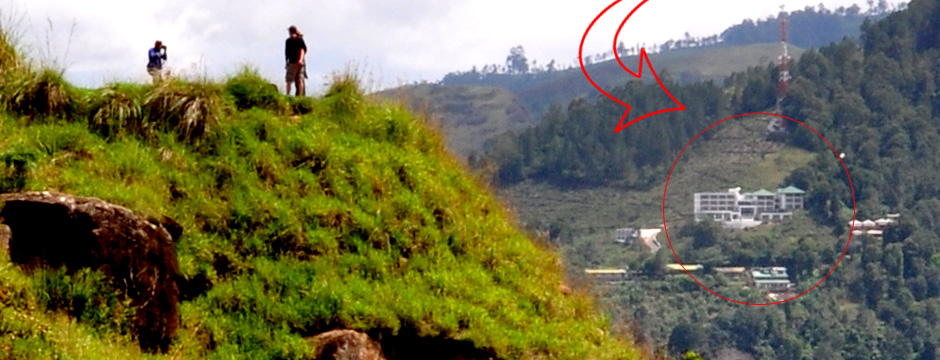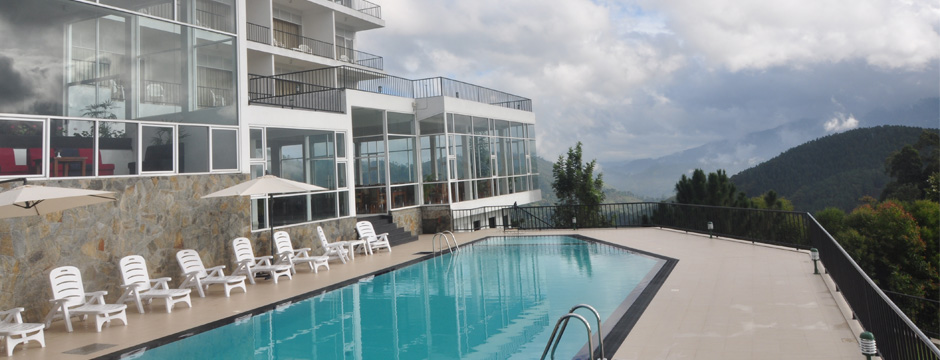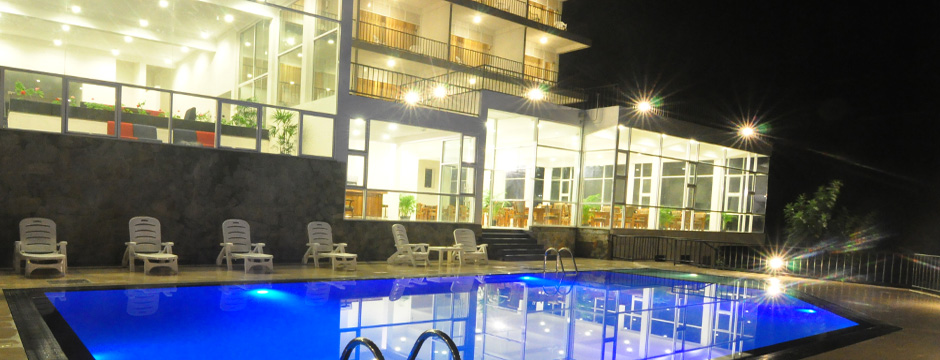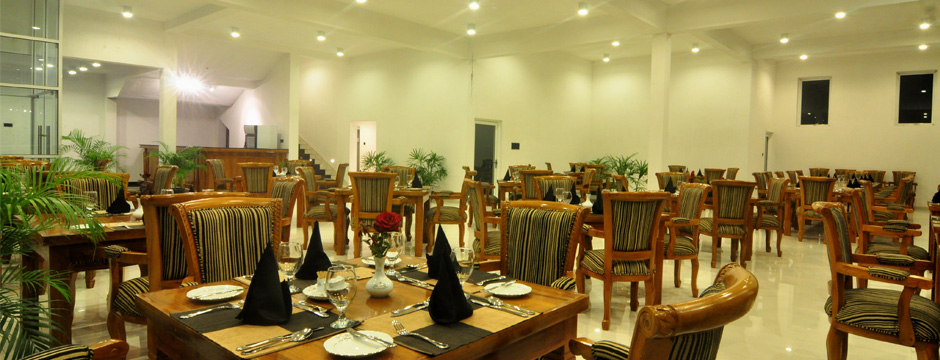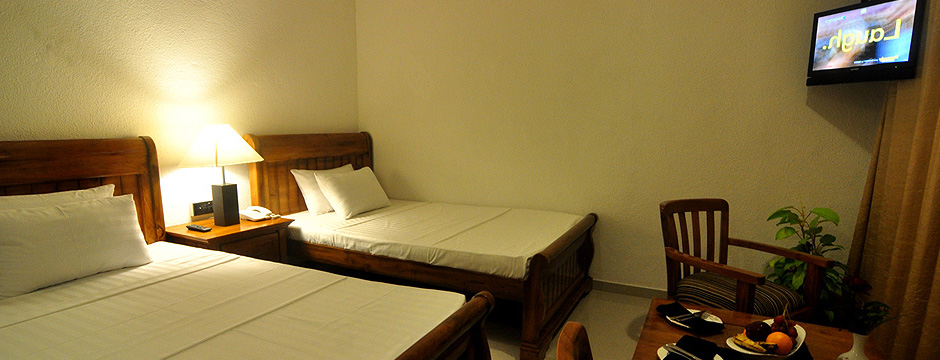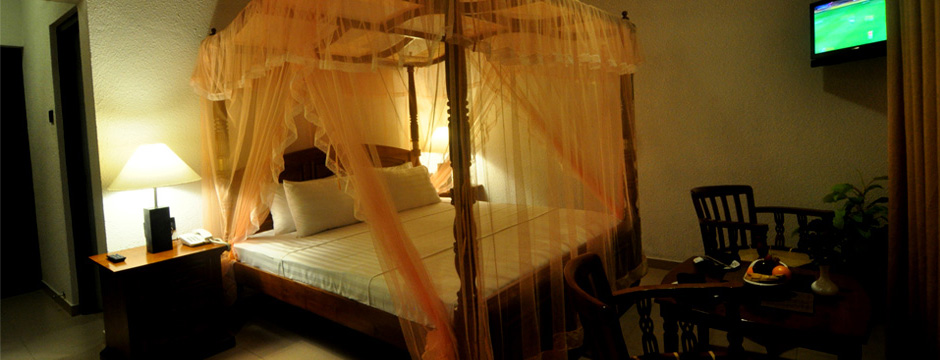Attractions and Things to do

Things To Do
Hiking / Tracking & Excursions
Ella is very popular for trekking and mountain climbing because of the rocky area surrounded. The comfortable climate and surrounded forestry environment offers these activities more interesting.
The mini jungles around the area provides ideal settings for hard adventure like rope adventure and rope climbing
Take a walk through the tea plantations to Little Adam's Peak south-east of the town centre, and about 25 minutes away.
For more strenuous exercise walk to the top of Ella Rock (1150m) for views across the Hill Country and with the town nestled in the hills below you. This walk is about 2 hours each way, and about half of it is along the railway line before cutting off into the hills. For a longer walk, rather than head straight back to the line from the hill top, follow the track through the forest. (You can't really get lost. Just head downhill when you've had enough, and before long you will meet a road or the railway line.)
The locals who live near the bottom of Ella Rock have recently come up with a wonderful piece of inventive free enterprise. They obliterate existing tracks up the hill and create new ones every now and then. Tourists following guidebooks get completely lost, and suddenly, Hey Presto! A local appears offering to guide them.
Biking
Landscapes in and around Ella offer the perfect settings for biking with its riveting scenery and climate. Especially suitable for biking enthusiasts this area includes some varied types of settings and terrains such that you can combine your love for cycling with exploring the rural lifestyle.
Bird / Butterfly Watching
The area is very popular with bird / Butterfly watchers. Endemic species of this part of the country include the yellow-eared bulbul, the fantailed warbler, the ashy-headed babbler, the Ceylon hill white eye, the dusky blue flycatcher and the Ceylon magpie robin. Most commonly seen birds are spotted dove, white delight drongo, brown headed barbet, parrot, gray wagtail, forest wagtail, blue winged leaf bird, mountain hawk eagle, asian paradise flycatcher
Common Butterflies that can be seen the area : crimson rope, peacock pony, tree nymph, plain tiger, blue mormon, chocolate soldier, Ceylon bird wing, great egg fly
Tea Factory Visit
Visit the Uva Halpewatta Tea Factory or Kinnaland Tea Factory in Ella and see for yourselves the manufacturing process of tea. This is also an opportunity to taste and buy the many varieties superior-quality, high-grown Ceylon tea, fresh from the factory itself.
For more details see: www.halpetea.com/tours.html
Local Events
. Every Wednesday - Weekly Wednesday Fair (Pola) in Ella
. May - Dova Temple Perahera
. June - Kumbal Perehara in Ella
. April 12th-16th - Sinhala and Tamil New Year Festival
. August - Halpewatte Estate Kovil Ceremony
Stay healthy...
Don't walk in the countryside in shorts and sandals / flip-flops, especially after it's been raining. There are lots of leeches that hang on to the vegetation by the side of tracks waiting for a nice juicy mammal to walk by. They're perfectly harmless really and if one attaches itself to you it's best to just let it drink its fill and drop off again. You have lots of blood and can spare one or two c.c. It is advisable to take some lime / Soap water with you, and drop on the leach. It will not kill the leach like in cigarette, but it will make the leach quickly leave you without drinking blood
Places of Attraction
Uva, Sri Lanka's fourth largest province is blessed with diverse tourist attractions and makes an ideal environment for enjoyable and relaxed vacation. The exciting attractions in the province include varied beauty of nature such as waterfalls, wildlife, mountain peaks, valleys, deep slopes etc, impressive archaeological sites with historical value, vast agricultural lands including greenish tea plantations, paddy fields and many other crop cultivations, colorful cultural events and traditions, wonderful creations of man and climate varied from cool mild to hot sunny. Thousands of locals and foreigners from all over the world visit this paradise to entertain this unforgettable experience full of diversity. You are always welcome to this incomparable land and have an exciting vacation that you can always remind with pleasure.
Nature
Ella Gap
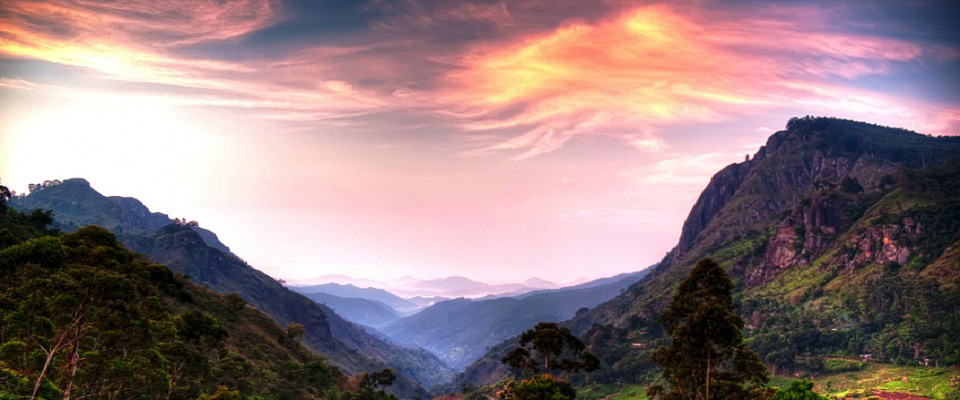 Overlooks a spectacular gap in the southern mountain wall where the land falls away in a dizzy drop of 3000 ft (915m), to the southern plains and the sea, which is visible in the far distance on a clear day. "Heaven's Edge" is beautifully located overlooking the gap with the black towering Ella Rock on the side and a wooded ridge on the other. The road to Wellawaya through the Ella Gap is a spectacular one, winding the mountains in a series of sharp drops.
Overlooks a spectacular gap in the southern mountain wall where the land falls away in a dizzy drop of 3000 ft (915m), to the southern plains and the sea, which is visible in the far distance on a clear day. "Heaven's Edge" is beautifully located overlooking the gap with the black towering Ella Rock on the side and a wooded ridge on the other. The road to Wellawaya through the Ella Gap is a spectacular one, winding the mountains in a series of sharp drops.
Horton Plains / World's End
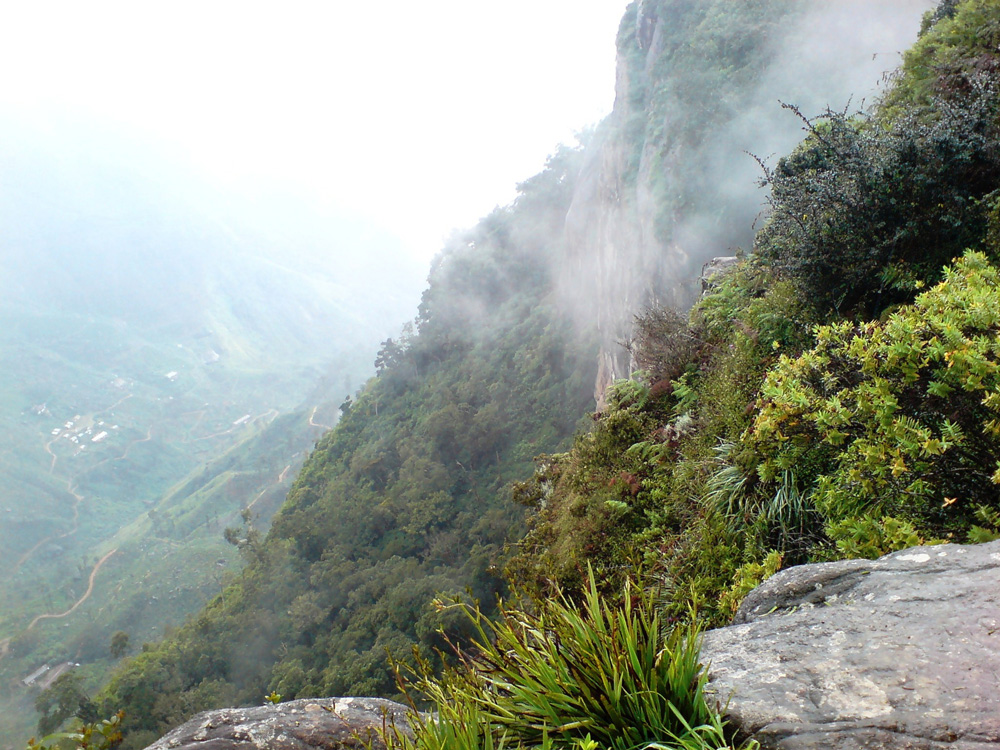 Sri Lanka's highest and most isolated plateau at an altitude of almost 1900 meters.
2 hours drive from "Heaven's Edge". Alternatively, you could travel by train to the Ohiya railway station and trek from there. The Horton Plains National Park is the only National Park situated in the Hill Country. Nature lovers would love this wide, Patna-grass covered plain. The grassy plains, which are interspersed with small patches of forest, are home to many wild animals including, leopards, sambar and monkeys. This is also one of the top destinations for bird watches who can observe an impressive bird life, including some endemic species. The most dramatic feature of the National Park is 'World's End' where the plateau comes to an abrupt end and drops nearly 1000m vertically. The view is magnificent on a clear day.
Sri Lanka's highest and most isolated plateau at an altitude of almost 1900 meters.
2 hours drive from "Heaven's Edge". Alternatively, you could travel by train to the Ohiya railway station and trek from there. The Horton Plains National Park is the only National Park situated in the Hill Country. Nature lovers would love this wide, Patna-grass covered plain. The grassy plains, which are interspersed with small patches of forest, are home to many wild animals including, leopards, sambar and monkeys. This is also one of the top destinations for bird watches who can observe an impressive bird life, including some endemic species. The most dramatic feature of the National Park is 'World's End' where the plateau comes to an abrupt end and drops nearly 1000m vertically. The view is magnificent on a clear day.
Little Adam's Peak
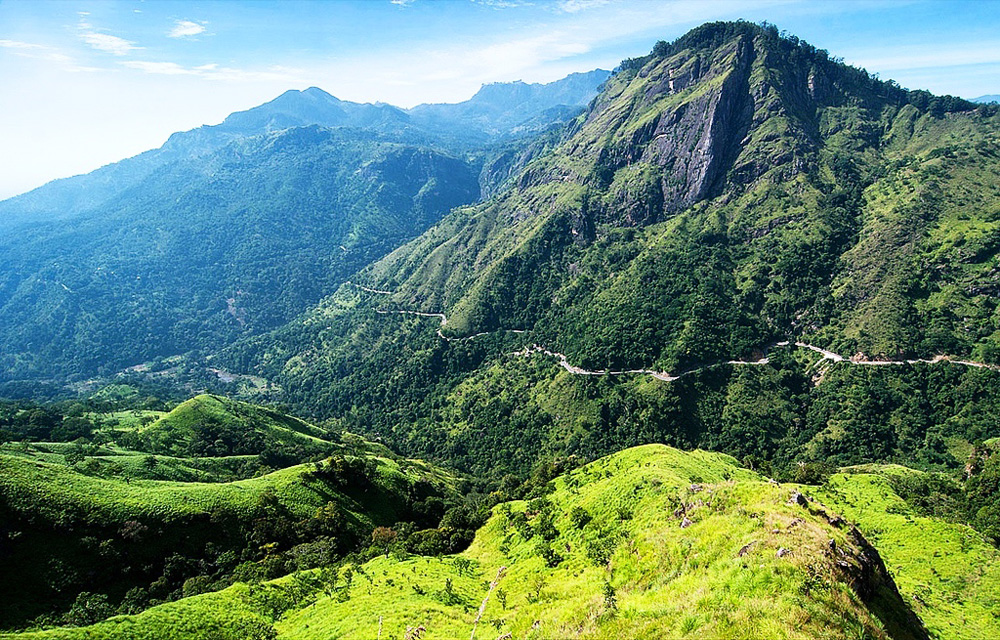 Madulsima mountain range at the border of the Uva Province plunges to the eastern plains offering an enchanting panorama. 15 minutes from the hotel by surface.
Travel 01Km Namunukula / Passara Road and turn at Sachini Flower Nursery and proceed on the gravel road up to Little Adam's Peak. A 45 minutes walk from Ella Town.
Madulsima mountain range at the border of the Uva Province plunges to the eastern plains offering an enchanting panorama. 15 minutes from the hotel by surface.
Travel 01Km Namunukula / Passara Road and turn at Sachini Flower Nursery and proceed on the gravel road up to Little Adam's Peak. A 45 minutes walk from Ella Town.
Thangamalai Nature Reserve
Very much popular with bird lovers where a large selection of Sri Lanka's 427 bird species are found. 45 minutes from the hotel by surface.
Water Falls
Diyaluma
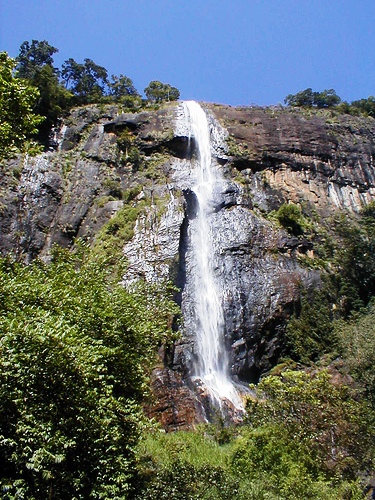 This is in the Koslanda area, 24 km from Beragala along Wellawaya road. This is the second highest waterfall in the Uva Province. Having the height of 560ft (170.69m) throughout the year the waterfall down the cliff to a dark rock creating an unforgettable picture of the mind of the viewer, one can climb up to the top of the falls if going along Poonagala road. There is a natural pool on the top of the falls. Elephants are also found in this area.
50 minutes from the hotel by surface.
This is in the Koslanda area, 24 km from Beragala along Wellawaya road. This is the second highest waterfall in the Uva Province. Having the height of 560ft (170.69m) throughout the year the waterfall down the cliff to a dark rock creating an unforgettable picture of the mind of the viewer, one can climb up to the top of the falls if going along Poonagala road. There is a natural pool on the top of the falls. Elephants are also found in this area.
50 minutes from the hotel by surface.
Dunhida
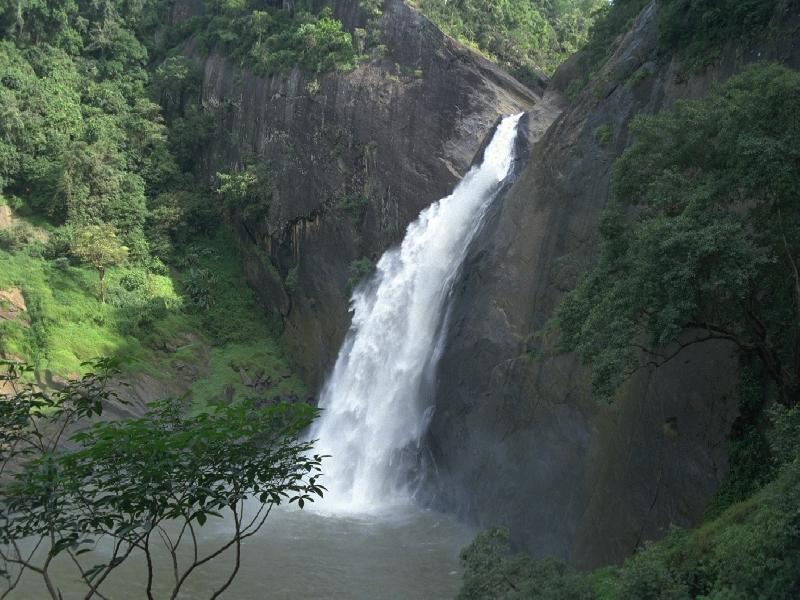 The Badulu Oya creates the most attractive, artistic cataract in Sri lanka, which is also known as the Dunhinda " the smoky water". The height is 190 ft (57.91 m) though it is beautifully visible throughout the year, it becomes very active from November to April. To reach this falls there are 5 km from Badulla along Mahiyangana road and from there one has to walk through the jungle. It is also a wonderful experience for the tourists.
There are some legends about this falls. In the 14th century princess Mampitiya Anuhas Manike Bandara fled with her lover, the commoner Kahapitiya Arachchi Bandara, from the wrath of her father, the ruler of Gampola. Frustrated by the inability to erase tracks and traces of wherever they found refugee, the lovers fledging their eternal love, plunged themselves into the depths of the pool. it is said following their tragedy, more tragedy fell upon the surroding villages. A terrible strong swept away the whole villages including Kosgolla, together with people, cattle, poultry and all. The name of the princess " Anuhas" in sinhalese means "supernatural powers". Another legend is associated with and entrance to a secret 30 km long passageway hidden by the falls. Treasure of prince Kumarasinghe of Uva lies hidden somewhere in the falls.
45 minutes from the hotel by surface.
The Badulu Oya creates the most attractive, artistic cataract in Sri lanka, which is also known as the Dunhinda " the smoky water". The height is 190 ft (57.91 m) though it is beautifully visible throughout the year, it becomes very active from November to April. To reach this falls there are 5 km from Badulla along Mahiyangana road and from there one has to walk through the jungle. It is also a wonderful experience for the tourists.
There are some legends about this falls. In the 14th century princess Mampitiya Anuhas Manike Bandara fled with her lover, the commoner Kahapitiya Arachchi Bandara, from the wrath of her father, the ruler of Gampola. Frustrated by the inability to erase tracks and traces of wherever they found refugee, the lovers fledging their eternal love, plunged themselves into the depths of the pool. it is said following their tragedy, more tragedy fell upon the surroding villages. A terrible strong swept away the whole villages including Kosgolla, together with people, cattle, poultry and all. The name of the princess " Anuhas" in sinhalese means "supernatural powers". Another legend is associated with and entrance to a secret 30 km long passageway hidden by the falls. Treasure of prince Kumarasinghe of Uva lies hidden somewhere in the falls.
45 minutes from the hotel by surface.
Babarakanda
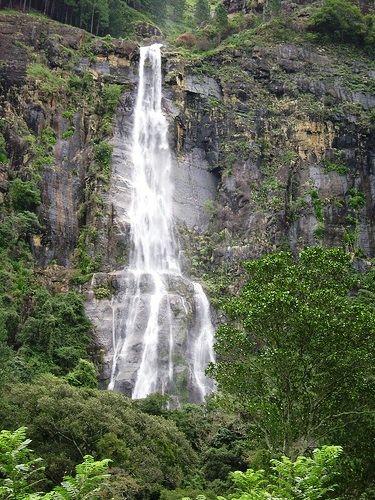 Bambarakanda falls is the highest waterfall in Sri Lanka with a height of 790 ft (240.79m). To reach this falls one should proceed on Badulla - Colombo road up to Weerakoongama junction in Haldummulla area. From weerakoongama there are 5 km to the right. This is situated in a very secluded area and beautifully visible from November to February. The beauty of the falls is that the whole stream sways to and fro due to the very strong winds blowing across it.
1.5 Hours from the hotel by surface.
Bambarakanda falls is the highest waterfall in Sri Lanka with a height of 790 ft (240.79m). To reach this falls one should proceed on Badulla - Colombo road up to Weerakoongama junction in Haldummulla area. From weerakoongama there are 5 km to the right. This is situated in a very secluded area and beautifully visible from November to February. The beauty of the falls is that the whole stream sways to and fro due to the very strong winds blowing across it.
1.5 Hours from the hotel by surface.
Rawana Ella Waterfall
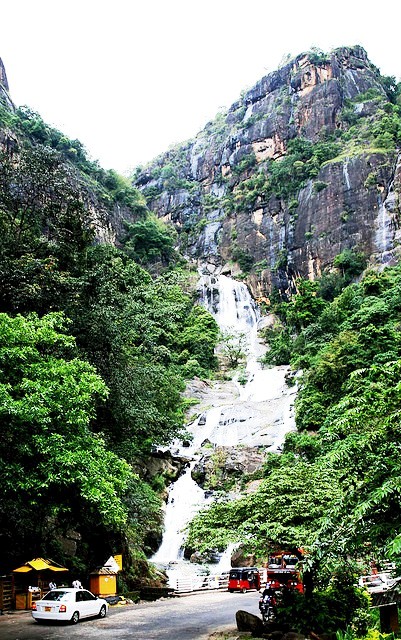 This waterfall is situated on the Ella-Wellawaya road 18 km away from bandarawela. This is a wide waterfall and the height is 40 m. Rawana fall origins from Kirindi Oya. It is really an attractive falls with a charming environment. This is also associated with the romantic legend of Rama & Sitha narrated in the ancient Indian epic poeme, Ramayana. According to folklore, King Rawana of Sri Lanka had hidden the beautiful princess Sitha whom he abducted after defeating her husband prince Rama of India. 20 minutes from the hotel by surface.
This waterfall is situated on the Ella-Wellawaya road 18 km away from bandarawela. This is a wide waterfall and the height is 40 m. Rawana fall origins from Kirindi Oya. It is really an attractive falls with a charming environment. This is also associated with the romantic legend of Rama & Sitha narrated in the ancient Indian epic poeme, Ramayana. According to folklore, King Rawana of Sri Lanka had hidden the beautiful princess Sitha whom he abducted after defeating her husband prince Rama of India. 20 minutes from the hotel by surface.
Manawela Waterfall
This is situated 5 km away on the Welimada Udupussellawa, Lunuwatta road. According to the folklore this place was the bathing place of King Rawana and one of tunnels to the harem runs up to here.
Another folklore is that King Walagamba had hidden here for his safety. There is a stone seat on the slap of the rock here and there are some pits to fix the stone pillars, which can be seen even today. The height is 60 ft(18.29m) and it is active from October to April.
Bomburu Waterfall
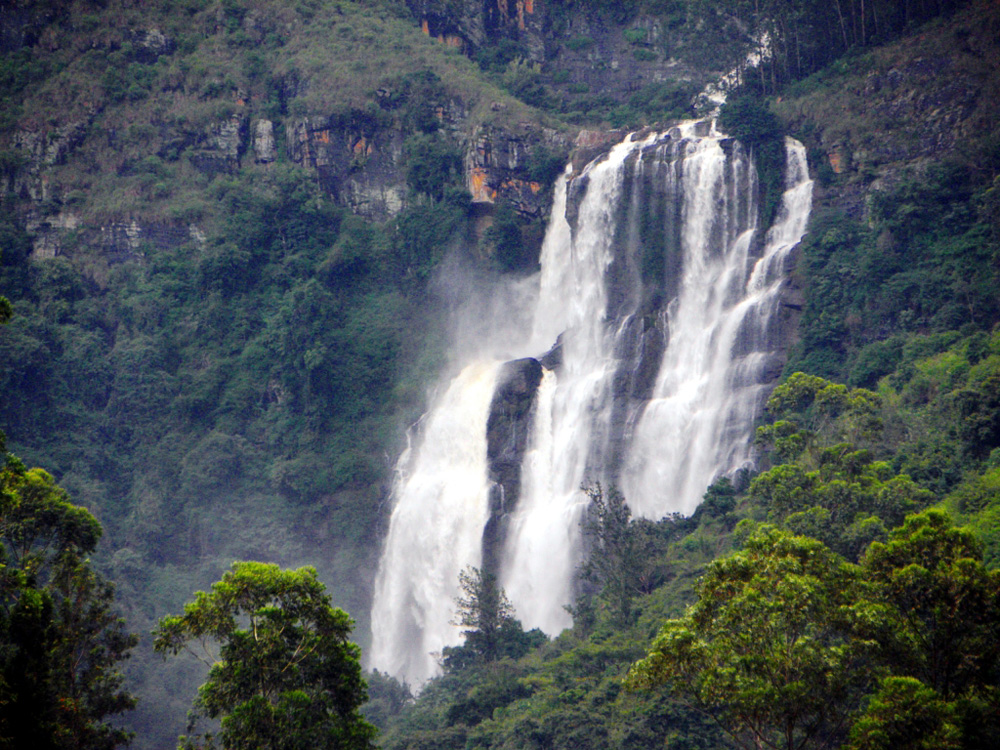 This is 15 km away from Welimada in the village of Perawella. One has to travel from Welimada along Uduhawara- Perawella road via Ambagasdowa up to Peawella village. From there, a walking distance of about 1.5 km. The height is 164 ft (57.07m). It falls down to a large pool.
This is 15 km away from Welimada in the village of Perawella. One has to travel from Welimada along Uduhawara- Perawella road via Ambagasdowa up to Peawella village. From there, a walking distance of about 1.5 km. The height is 164 ft (57.07m). It falls down to a large pool.
National Parks / Sanctuaries
Yala National Park
 Yala National Park is 309 km south of Colombo on the southeast of the island. It is well known for its biggest, extensive area of 1,259 sq km, and for its best wildlife preservation in the country. With it's considerable size, the terrain of the national park is varied from flat plains to rocky outcrops. The vegetation ranges from open parkland to dense jungle. There are also abundance of water supply for animals and birds ranging from waterholes, streams, small lakes to lagoons. The national park is divided into Yala West (also called Ruhuna) and Yala East.
Yala West or Ruhuna National Park is now well recognized as the best park in the world to observe and photograph leopards. There are about 35 leopards in the park which probably is the highest density than anywhere in the world. It is possible to take one day jeep-safari trip through the park although it takes you three days to see the entire park. The park is usually closed relatively late (almost 7.00 pm) therefore, the chance to come across one of the leopards is quite high. As well as leopards, there are a large number of elephants living inside the park and these can be seen bathing in any of the numerous lakes within the park. Other animals living in the park include sloth bear, spotted deer, barking deer, mouse deer, toque monkey, stripe-necked mongoose, ruddy mongoose, wild pig, jackal, water monitor, marsh crocodile and estuarine crocodile.
Yala National Park is 309 km south of Colombo on the southeast of the island. It is well known for its biggest, extensive area of 1,259 sq km, and for its best wildlife preservation in the country. With it's considerable size, the terrain of the national park is varied from flat plains to rocky outcrops. The vegetation ranges from open parkland to dense jungle. There are also abundance of water supply for animals and birds ranging from waterholes, streams, small lakes to lagoons. The national park is divided into Yala West (also called Ruhuna) and Yala East.
Yala West or Ruhuna National Park is now well recognized as the best park in the world to observe and photograph leopards. There are about 35 leopards in the park which probably is the highest density than anywhere in the world. It is possible to take one day jeep-safari trip through the park although it takes you three days to see the entire park. The park is usually closed relatively late (almost 7.00 pm) therefore, the chance to come across one of the leopards is quite high. As well as leopards, there are a large number of elephants living inside the park and these can be seen bathing in any of the numerous lakes within the park. Other animals living in the park include sloth bear, spotted deer, barking deer, mouse deer, toque monkey, stripe-necked mongoose, ruddy mongoose, wild pig, jackal, water monitor, marsh crocodile and estuarine crocodile.
Also, 130 species of birds have been recorded here, they includes Sri Lanka Jungle Fowl, Brown-capped Babbler, Stone Curlew, Greater Thick-knee, Black-necked Stork, Lesser Adjutant, Painted Stork, Shirker Malkoha, Blue-faced Malkoha, Green Bee-eater, Pompadour Green Pigeon, Blue-faced Malkoha, Green Bee-eater Orange-breasted Green Pigeon, Malabar Pied Hornbill, Brahminya Myna and Rose-colored Starling. A large variety of water birds also can be seen in the Kumana Mangrove Swamp inside the Yala East, which is 180 sq km in extent. Yala East National Park can be entered at Okanda, 25 km down the coast track south of Arugam Bay via the small town of Panama. Going to Yala East can be arranged from Arugam Bay.
Udawalawe National Park
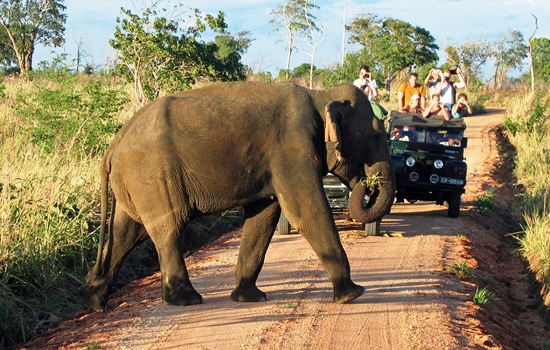 The Udawalawa National Park situated in the dry zone of the country and belongs to Sabaragamuwa and Uva provinces. The park area is 30,821 ha. The park was established in 1972.The park lies within dry zone and small segment lies within intermediate zone. The long dry season is a characteristic feature. Main source of rainfall is southwest monsoon (May to September) and mean annual rainfall is about 1520mm. The mean annual temperature is around 29C. Park consists of dry lowland forest, revering forest, thorny scrublands and grasslands. One special attraction of the park is the Udawalawe reservoir and the Walawe River which flows through the park.
The Udawalawa National Park situated in the dry zone of the country and belongs to Sabaragamuwa and Uva provinces. The park area is 30,821 ha. The park was established in 1972.The park lies within dry zone and small segment lies within intermediate zone. The long dry season is a characteristic feature. Main source of rainfall is southwest monsoon (May to September) and mean annual rainfall is about 1520mm. The mean annual temperature is around 29C. Park consists of dry lowland forest, revering forest, thorny scrublands and grasslands. One special attraction of the park is the Udawalawe reservoir and the Walawe River which flows through the park.
Udawalawe National Park is world famous for its large elephant population. In this park one can observe elephants at any given time of the day. Other than Elephants water buffalos, spotted and barking deer, wild boar, tambour, jackal & ruddy, grey and striped necked mongoose are also found in this park. Though the leopard, jungle and fishing cats have been recorded in the park, sightings are very rare. The park is also famous for birdlife. Crested serpent eagle, changeable hawk eagle, white-bellied sea eagle & grey-headed fishing eagle are the main raptors found in the park. Painted stork, open bill, little & Indian cormorant, Indian darter, many species of waders are also found within the park. Among the forest birds are the warblers, Sri Lanka Jungle fowl, Malabar pied hornbill, Skier Malkoha, Blue face Malkoha, common Causal, and grey hornbill. Udawalawe is easily accessible via Ratnapura after a 4 hours drive. You can also reach Udawalawe from Down south via Hambantota.
Archeological Sites
Muthiyangana Temple
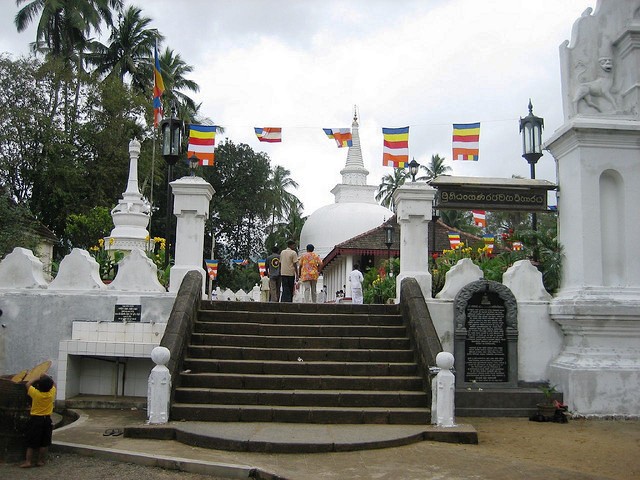 This is situated in Badulla, 0.5 km away from the town. The name has been used since the earliest period of this temple. According to the legend, the name came into use as the Stupa was build by enshrining the relic of the drops of sweat of the Lord Buddha.
This is one of the most sacred places of the Buddhist out of sixteen sacred places (Solosmastana) in Sri Lanka. According to the disciplinary commentary (Vinaya Pitakeya) "Samantha Pasadika" written by the priest Buddhaghosha, the Buddha has stayed here in his visit to Sri Lanka in the 8th year of his enlightenment. It is also said that the Buddha has been in attainment of cessation (Nirodha Sampaththi) here with five hundred Arhaths. The gorgeous Perahera is the center of attraction held every year in the Muthiyangana temple.
This is situated in Badulla, 0.5 km away from the town. The name has been used since the earliest period of this temple. According to the legend, the name came into use as the Stupa was build by enshrining the relic of the drops of sweat of the Lord Buddha.
This is one of the most sacred places of the Buddhist out of sixteen sacred places (Solosmastana) in Sri Lanka. According to the disciplinary commentary (Vinaya Pitakeya) "Samantha Pasadika" written by the priest Buddhaghosha, the Buddha has stayed here in his visit to Sri Lanka in the 8th year of his enlightenment. It is also said that the Buddha has been in attainment of cessation (Nirodha Sampaththi) here with five hundred Arhaths. The gorgeous Perahera is the center of attraction held every year in the Muthiyangana temple.
Dowa Rock Temple (Dowa Raja Maha Viharaya)
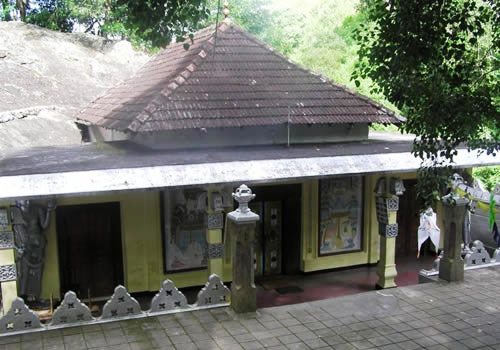 Dowa Rock Temple is situated by the Bandarawela - Badulla road 4.5 km away from Bandarawela. This belongs to king Walagamba era. In the past, this was known as the Kumbaltispaha vihara and later on as Ariyakara Temple. Frescoes and inscriptions belong to the first century B.C. The most attractive feature is the 36 ft (10.98m) incomplete standing statue of the Load Buddha carved out of a stone cliff. Inside the cave covered by drip-ledges are full of frescoes belong to into Kandyan period. The gorgeous Perahera is centre of attraction held in every year.
Dowa Rock Temple is situated by the Bandarawela - Badulla road 4.5 km away from Bandarawela. This belongs to king Walagamba era. In the past, this was known as the Kumbaltispaha vihara and later on as Ariyakara Temple. Frescoes and inscriptions belong to the first century B.C. The most attractive feature is the 36 ft (10.98m) incomplete standing statue of the Load Buddha carved out of a stone cliff. Inside the cave covered by drip-ledges are full of frescoes belong to into Kandyan period. The gorgeous Perahera is centre of attraction held in every year.
Maligawila Buddha Statue
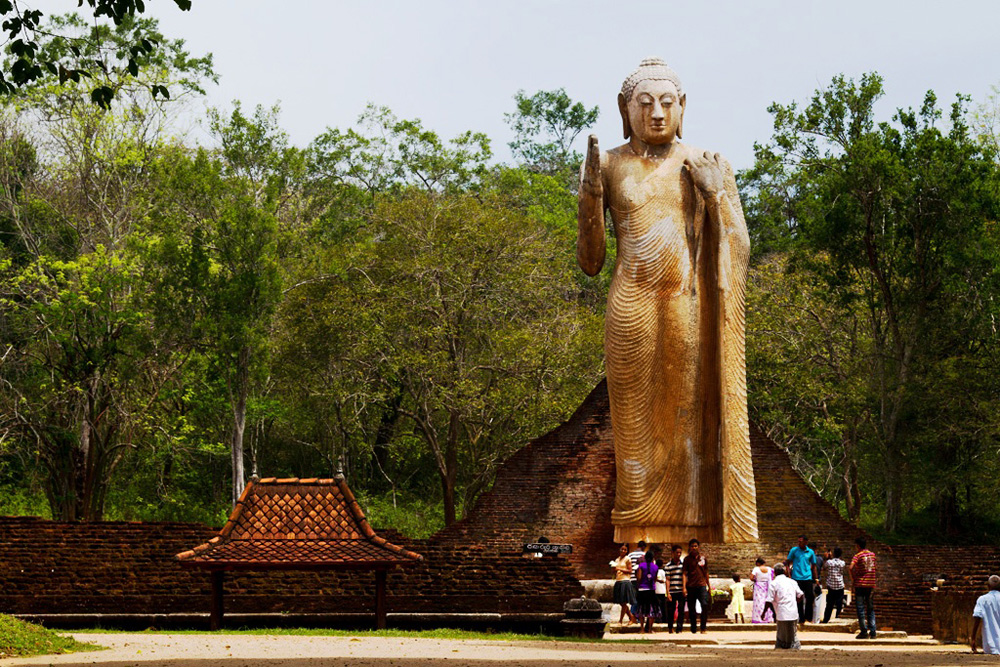 There are two ways to reach this temple. One is Kumbukkana- Maligavila road. Its distance is 14 km. The other access is the Buththala Okkampitiya road via Helagama with a distance of 16 km. The statue of Maligawila has captured a highest position among the statues in the Asia. This was built by King Dhappula VII while the Mahawansa says that this statue was constructed by the King Aggabodhi. In the chronicle Mahawansa and also in other compositions, this temple is mentioned by other names such as Ariyakara temple and Ariyakoth temple. Maligawila is famous for the statue of standing posture of the Load Buddha. This has been made using a special lime stone and it was established here transporting from some other area. The chronicles say that King Aggabodhi has constructed a rock statue in the village of Kanagama in Southern part of Sri Lanka. It has been revealed that Kanagama is the ruins of Maligavila. The height of this statue is 34 ft (10.37m) and the width in the shoulder part is 10 feet (3.05m).
There are two ways to reach this temple. One is Kumbukkana- Maligavila road. Its distance is 14 km. The other access is the Buththala Okkampitiya road via Helagama with a distance of 16 km. The statue of Maligawila has captured a highest position among the statues in the Asia. This was built by King Dhappula VII while the Mahawansa says that this statue was constructed by the King Aggabodhi. In the chronicle Mahawansa and also in other compositions, this temple is mentioned by other names such as Ariyakara temple and Ariyakoth temple. Maligawila is famous for the statue of standing posture of the Load Buddha. This has been made using a special lime stone and it was established here transporting from some other area. The chronicles say that King Aggabodhi has constructed a rock statue in the village of Kanagama in Southern part of Sri Lanka. It has been revealed that Kanagama is the ruins of Maligavila. The height of this statue is 34 ft (10.37m) and the width in the shoulder part is 10 feet (3.05m).
Dambegoda Bodhisatwa Statue
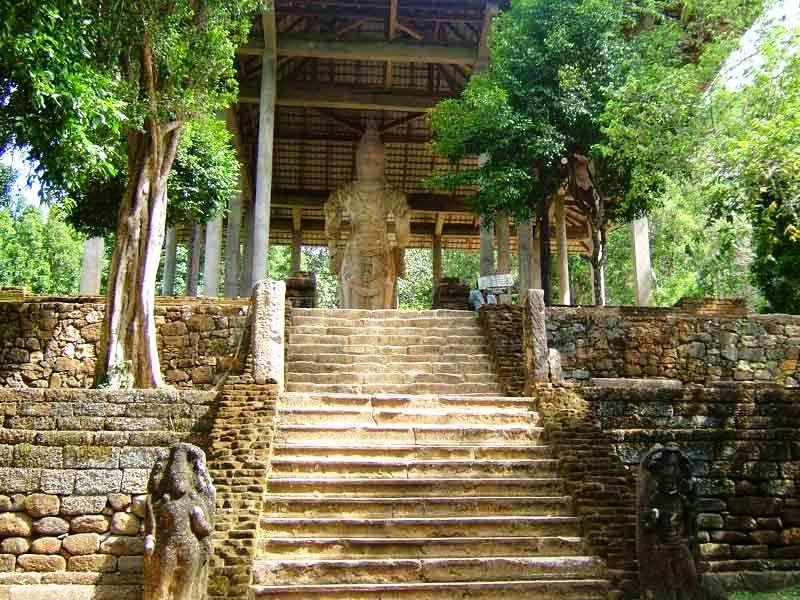 Dambegoda Maithree Bodhisathwa statue is situated about 300 meters from Maligavila statue facing the east. According to the chronicle Mahawansa, this statue belongs to the 8th century constructed by king Dhappula I, a brother of a powered King Agbo in the south. This was made by lime stone on a base of a flower of 14 ft (4.27m), 10.5 inches (26.5cm) height and 30 ft (9.2m) circumference. The statue represents the Awaloketheswara Bodhisathwa belongs to the traditions of Mahayana. Both Maligavila statue and DAmbegoda Bodhisathwa statue are made of a Kind of lime stone. This is the second to none of any statue of this kind in the world.
Dambegoda Maithree Bodhisathwa statue is situated about 300 meters from Maligavila statue facing the east. According to the chronicle Mahawansa, this statue belongs to the 8th century constructed by king Dhappula I, a brother of a powered King Agbo in the south. This was made by lime stone on a base of a flower of 14 ft (4.27m), 10.5 inches (26.5cm) height and 30 ft (9.2m) circumference. The statue represents the Awaloketheswara Bodhisathwa belongs to the traditions of Mahayana. Both Maligavila statue and DAmbegoda Bodhisathwa statue are made of a Kind of lime stone. This is the second to none of any statue of this kind in the world.
Buduruwagala
 This historical site consists of seven statues carved out from a rock which appears as an elephant down on its knees when viewed from a distance. Among these statues, one is 51 ft high which is considered as the highest rock carved Buddha statue in Sri Lanka. On either side of this, statues of Avaloketheswara Bodhisathwa have been carved out according to Mahayana tradition. These statues are located at the temple of Buduruwagala, 2km off Buduruwagala junction on Wallawaya - Thanamalwila road.
This historical site consists of seven statues carved out from a rock which appears as an elephant down on its knees when viewed from a distance. Among these statues, one is 51 ft high which is considered as the highest rock carved Buddha statue in Sri Lanka. On either side of this, statues of Avaloketheswara Bodhisathwa have been carved out according to Mahayana tradition. These statues are located at the temple of Buduruwagala, 2km off Buduruwagala junction on Wallawaya - Thanamalwila road.
Katharagama Ancient Sacred Area
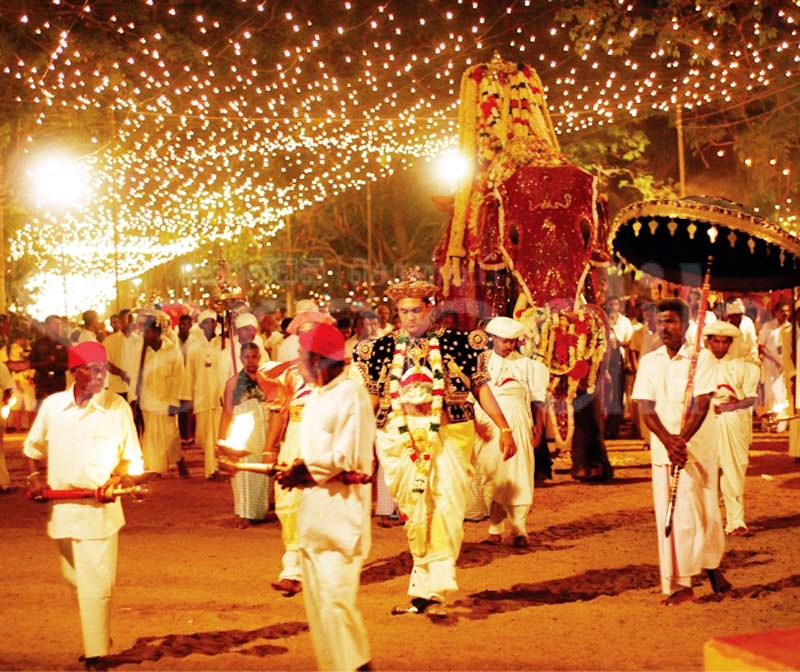 Kataragama is and ancient sacred riverside pilgrims site where all religions worshipped. Hindus,Buddhists, Muslims and christians visit this ancient site. The history and the legend run back to the prehistory. It is belived that King Dutugemunu, the warrior King and Sinhala folk hero, built a shrine here for the worship of the Kataragama God in the second centuery BC. There is also a first century BC Budhist dagoba, Kirivehara at this site. The Maha Devala, the main shrine of God Skandha, the Hindu war God, and several other adjoining Hindu shrines, conduct daily religious rituals(Puja). A large number of devotees visit here to fulfil their vows. The main festival is the procession (Perahera) which is held every year. Conch shells below, trumpets blare and drums beat out as voices rise in unison to a chorus of chants of "Haro Hara" elephant's parade, drummers, drum and bows are made. Some devotees seeking favors demonstrate their devotion to the God by performing extraordinary acts of penance and salf-motification tongues and cheeks are transfixed by spikes, butchers hooks penetrating their skin. Some devotees are suspended up in the air by and array of hooks and mounted on ox driven carts swing forth and backwards freely, others roll over the hot sands near the temple. Perades pilgrims take part in vibrant and vigorous Kavadi (peacock dance) men, women and children holding decorated semi circular red arches made of wood paper above their head dance to the beet of drummers and trumpeters.
The fire walkers, who had prepared themselves for the festival by acts of past meditate and pray for the last few weeks, at the end of the festival, take a rituals bath in the Menik Ganga and pay homage to the God Kataragama Maha Devala. Then they step out into the glowing beds of red-hot-cinders-while audience cries out encouragement.
The festival ends with a ceremony of water cutting: The waters of the Menik Ganga are "cut " with sword, at the moment of the full moon, symbolizes the separation of pure from impure and the invocations of rain for the harvest.
Kataragama is and ancient sacred riverside pilgrims site where all religions worshipped. Hindus,Buddhists, Muslims and christians visit this ancient site. The history and the legend run back to the prehistory. It is belived that King Dutugemunu, the warrior King and Sinhala folk hero, built a shrine here for the worship of the Kataragama God in the second centuery BC. There is also a first century BC Budhist dagoba, Kirivehara at this site. The Maha Devala, the main shrine of God Skandha, the Hindu war God, and several other adjoining Hindu shrines, conduct daily religious rituals(Puja). A large number of devotees visit here to fulfil their vows. The main festival is the procession (Perahera) which is held every year. Conch shells below, trumpets blare and drums beat out as voices rise in unison to a chorus of chants of "Haro Hara" elephant's parade, drummers, drum and bows are made. Some devotees seeking favors demonstrate their devotion to the God by performing extraordinary acts of penance and salf-motification tongues and cheeks are transfixed by spikes, butchers hooks penetrating their skin. Some devotees are suspended up in the air by and array of hooks and mounted on ox driven carts swing forth and backwards freely, others roll over the hot sands near the temple. Perades pilgrims take part in vibrant and vigorous Kavadi (peacock dance) men, women and children holding decorated semi circular red arches made of wood paper above their head dance to the beet of drummers and trumpeters.
The fire walkers, who had prepared themselves for the festival by acts of past meditate and pray for the last few weeks, at the end of the festival, take a rituals bath in the Menik Ganga and pay homage to the God Kataragama Maha Devala. Then they step out into the glowing beds of red-hot-cinders-while audience cries out encouragement.
The festival ends with a ceremony of water cutting: The waters of the Menik Ganga are "cut " with sword, at the moment of the full moon, symbolizes the separation of pure from impure and the invocations of rain for the harvest.
Ramayana Sites
Sri Lanka has more than 50 Ramayana sites from the place of Seetha Devi's captivity to the battlefields of war where Lord Rama slew Ravana, the ten-headed demon-king.
In Sri Lanka People still remember the connection of Lanka to the great epic. An oath taken at the spot where Seetha Devi undertook 'Agni Pariksha' is still considered valid in village courts or grama sabhas. It is said the colour of the soil of the ancient battlefield is still red today, and is still surrounded by lighter coloured earth. One of the airports of Ravana, torched by Hanuman when he came looking for Seetha Devi, still has a scorched-earth look.
A patch of darker soil surrounded by brown earth. Exotic alpine Himalayan species are found suddenly amidst tropical Sri Lankan vegetation, the legacy of Hanuman's heroic voyage carrying a mountain with life-restoring herbs.
The names of places are still unchanged, and are still well connected with the epic.
Read More : http://www.ramayanaresearch.com/ http://www.sltda.lk/ramayana#014
Rawana Cave
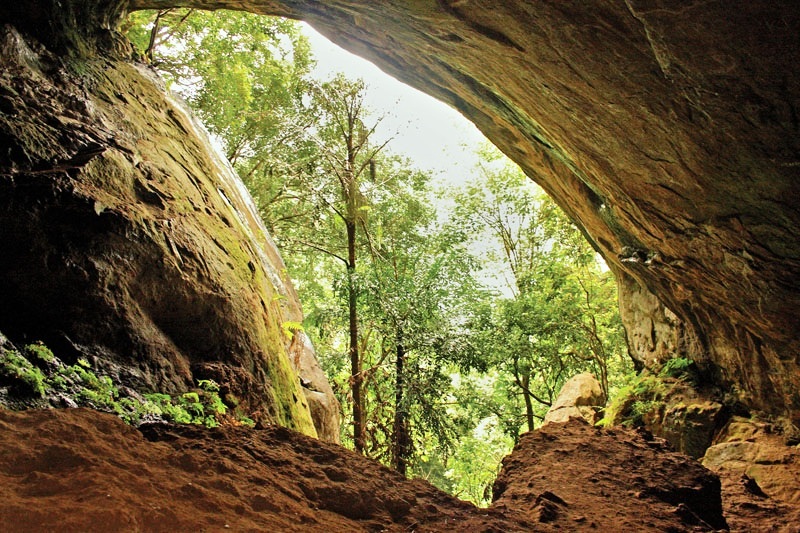 This is the place where Princes Sita was hidden by King Rawana. It is situated on a beautiful peak of a mountain and there is a tunnel way from here to Dowa Rajamaha Viharaya and still the ruins of it can be seen. By travelling 06 Km on Ella - Wallawaya Road turning right, proceeding another 01 Km to ancient Rawana Ella Rajamaha Viharaya and from there going through the stairs for about 500m this site can be seen.
This is the place where Princes Sita was hidden by King Rawana. It is situated on a beautiful peak of a mountain and there is a tunnel way from here to Dowa Rajamaha Viharaya and still the ruins of it can be seen. By travelling 06 Km on Ella - Wallawaya Road turning right, proceeding another 01 Km to ancient Rawana Ella Rajamaha Viharaya and from there going through the stairs for about 500m this site can be seen.
Legend: These tunnels prove beyond doubt the architectural brilliance of King Ravana. The tunnels served as a quick means of transport through the hills and also as a secret passage. They networked all the important cities, airports and dairy farms. A close look at these tunnels indicates that they are man-made and not natural formations.
Existing tunnel mouths are also situated at Ishtripura in Welimada, Senapitiya in Halagala, Ramboda, Labookelle, Wariyapola in Matale, and Seetha Kotuwa in Hasalaka and in many more places.
Sita Amman Kovil
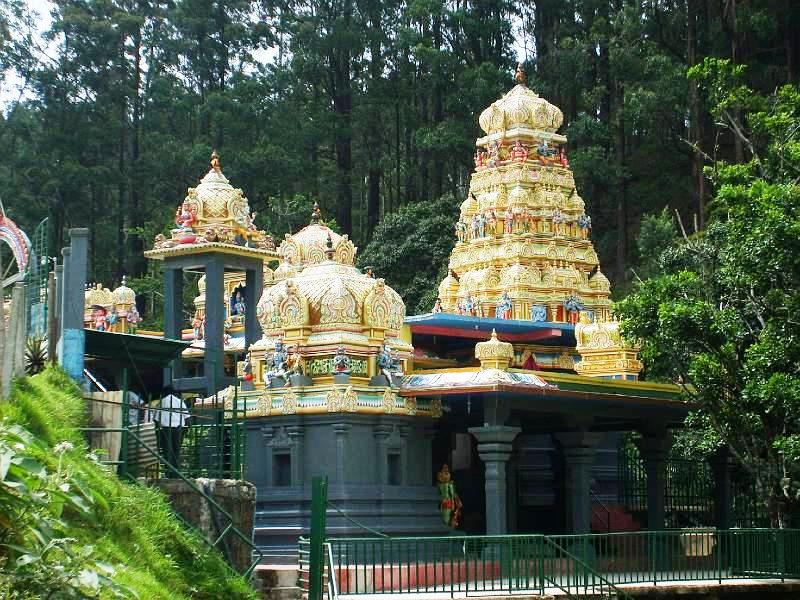 Situated bordering the main highway to Nuwara Eliya, This colorful shrine was created to pay homage to Princess Sita, Lord Rama, Luxshman and Hanuman. 90 minutes from the hotel by surface.
Situated bordering the main highway to Nuwara Eliya, This colorful shrine was created to pay homage to Princess Sita, Lord Rama, Luxshman and Hanuman. 90 minutes from the hotel by surface.
Legend: The temple was built on the sides of the stream where Seetha Devi bathed.
Divurumpola Temple
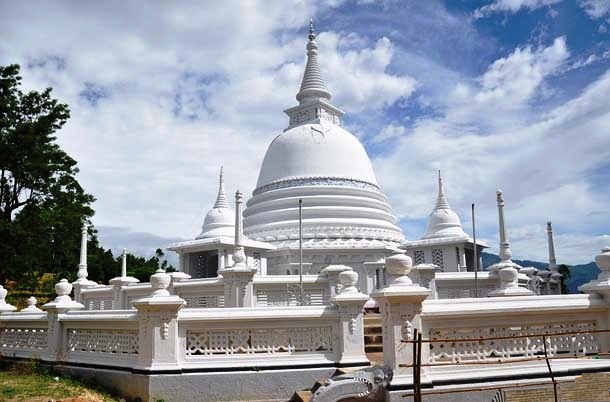 This is the place where Seetha Devi underwent "Agni Pariksha" (test). It is a popular place of worship among locals in this area. Divurumpola means place of oath in Sinhala. The legal system permits and accepts the swearing done at this temple while settling disputes between parties. 45 minutes from the hotel by surface.
This is the place where Seetha Devi underwent "Agni Pariksha" (test). It is a popular place of worship among locals in this area. Divurumpola means place of oath in Sinhala. The legal system permits and accepts the swearing done at this temple while settling disputes between parties. 45 minutes from the hotel by surface.
Yudaganawa / Yudaganawa Stupa
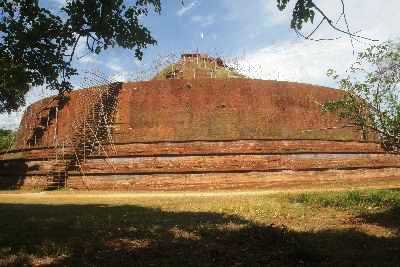 The history of this stupa runs back to the reign of king Mahanaga. The circumstance of the stupa is 1038 ft and contains many features relating to viharas. This stupa built by King Saddhatissa occupies a very special place among other stupas because of its hugeness. On the way to this stupa one can visit Chulangani Temple which has lot of ruins. Turning at Yudaganawa Junction on Wallawaya - Monaragala Highway and proceeding for 02 Km, one can reach this sacred place.
The history of this stupa runs back to the reign of king Mahanaga. The circumstance of the stupa is 1038 ft and contains many features relating to viharas. This stupa built by King Saddhatissa occupies a very special place among other stupas because of its hugeness. On the way to this stupa one can visit Chulangani Temple which has lot of ruins. Turning at Yudaganawa Junction on Wallawaya - Monaragala Highway and proceeding for 02 Km, one can reach this sacred place.
Other interesting sites
Bogoda Wooden Bridge / Temple
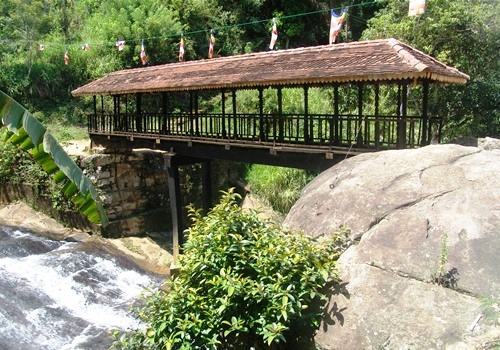 To reach this temple and the bridge, it is needed to travel along Galauda road via Ketawala from Hali-Ela town and then 3 km to the left from the Jagulla junction. There is a temple belong to the King Walagamba era with caves and ancient frescoes. The bridge is the only wooden Bridge in Sri Lanka with a roof above, which belongs to the Kandy era. The bridge has been built by placing 03 huge logs from Bogoda Ancient Temple across Gallanda stream. Either side of the bridge, there are 11 pairs of carved rails (Palisades). The roofing is done with Sinhala flat tiles. The timber is painted with a liquid made by an old recipe. The most significant feature of this bridge is that it has been built without using any nails.
To reach this temple and the bridge, it is needed to travel along Galauda road via Ketawala from Hali-Ela town and then 3 km to the left from the Jagulla junction. There is a temple belong to the King Walagamba era with caves and ancient frescoes. The bridge is the only wooden Bridge in Sri Lanka with a roof above, which belongs to the Kandy era. The bridge has been built by placing 03 huge logs from Bogoda Ancient Temple across Gallanda stream. Either side of the bridge, there are 11 pairs of carved rails (Palisades). The roofing is done with Sinhala flat tiles. The timber is painted with a liquid made by an old recipe. The most significant feature of this bridge is that it has been built without using any nails.
Nine Arch Bridge of Demodara (Arukku Nawaya Palama)
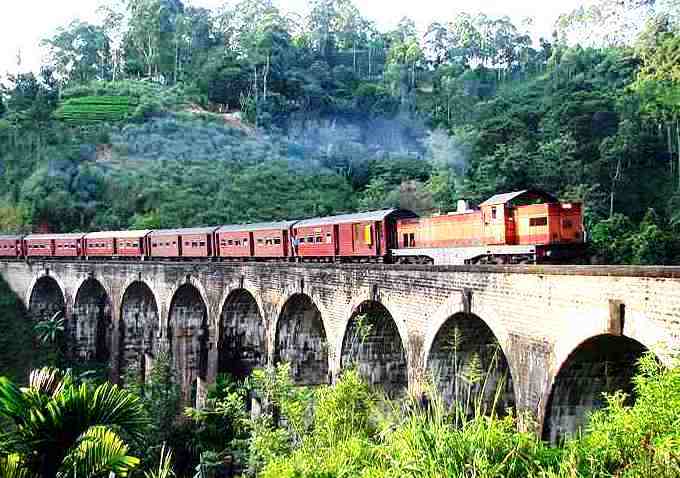 This Bridge is situated one Kilometer away on the Gotuwala road near the Sutherland bungalow on the left to two Kilometers away from Ella town along Passara road. This bridge belongs to the Madhuragama Grama Seva Division between Ella and Demodara Railway Stations. This name is used since the bridge contains of 09 arches. It is also known as "Ahas Nawaya Palama" (9 Skies Bridge) This Bridge is 300 feet (91.44m) long and 25ft (7.62m) wide. This bridge connects with two high lands and has been made of large cubic stones. The height is 80 ft (24.38m). The bridge has constructed with using an amazing engineering technology.
This Bridge is situated one Kilometer away on the Gotuwala road near the Sutherland bungalow on the left to two Kilometers away from Ella town along Passara road. This bridge belongs to the Madhuragama Grama Seva Division between Ella and Demodara Railway Stations. This name is used since the bridge contains of 09 arches. It is also known as "Ahas Nawaya Palama" (9 Skies Bridge) This Bridge is 300 feet (91.44m) long and 25ft (7.62m) wide. This bridge connects with two high lands and has been made of large cubic stones. The height is 80 ft (24.38m). The bridge has constructed with using an amazing engineering technology.
Adisham Bangalow ( St. Benedict's Church)
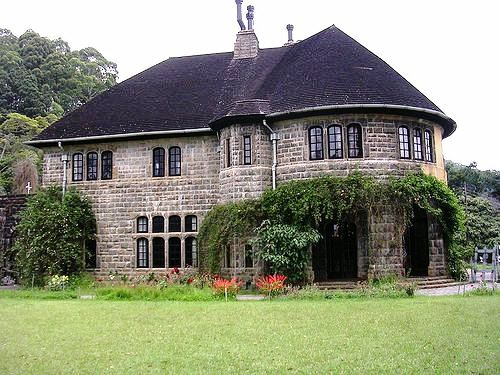 This is a historically and aesthetically important place which is located 3 km away from Haputale town. On a fine day, the places like Piduruthalagala, Kandapola, Ragala, Ambewea, Boralanda, Diyatalawa and Bandarawela can be viewed from here.
The founder was Sir Thomas Lester Villiers. He started building this in 1920 and competed in 1931. The fascinating creation was built by Indian architects and the bungalow consists of many rooms. The ceiling of each room has been beautified with different carvings. The two feet wide walls have been made of granite cubes. The floor has been plastered with cement and pasted with wall papers. The frames of the doors and windows were made of Oak wood. The roofing has been done by wooden plates / splints. It is considered that Villiers had imported all the materials from Scotland. The monastery bordering the Thangamalai bird sanctuary, the garden is homed to blue magpies,paradise flycatchers, green barbets, brilliant orange plumaged mini-verts hornbills, golden orioles and a host of other bird life.
This is a historically and aesthetically important place which is located 3 km away from Haputale town. On a fine day, the places like Piduruthalagala, Kandapola, Ragala, Ambewea, Boralanda, Diyatalawa and Bandarawela can be viewed from here.
The founder was Sir Thomas Lester Villiers. He started building this in 1920 and competed in 1931. The fascinating creation was built by Indian architects and the bungalow consists of many rooms. The ceiling of each room has been beautified with different carvings. The two feet wide walls have been made of granite cubes. The floor has been plastered with cement and pasted with wall papers. The frames of the doors and windows were made of Oak wood. The roofing has been done by wooden plates / splints. It is considered that Villiers had imported all the materials from Scotland. The monastery bordering the Thangamalai bird sanctuary, the garden is homed to blue magpies,paradise flycatchers, green barbets, brilliant orange plumaged mini-verts hornbills, golden orioles and a host of other bird life.
Lipton Seat
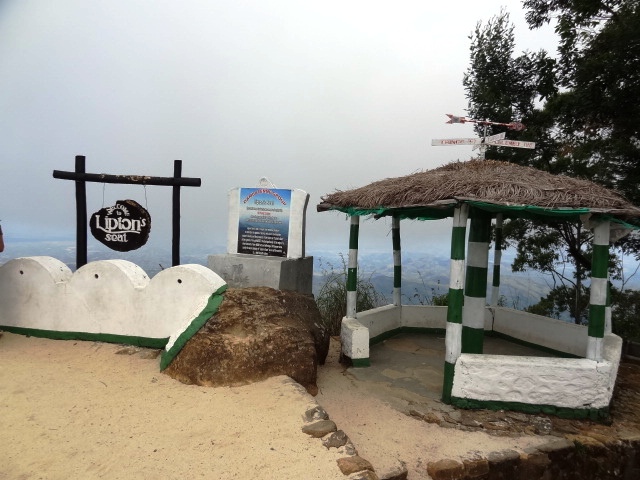 This is one of the highest points of the tea estate which was commenced by Sir Thomas Lipton. From the top of the hill, the beautiful Tea Estate can be seen and very important as a view point. When there is a clear weather faraway places five districts near Baudulla could be seen from here. This marvelous viewing point is located 17 km away from Haputale along Dambetenna road.
This is one of the highest points of the tea estate which was commenced by Sir Thomas Lipton. From the top of the hill, the beautiful Tea Estate can be seen and very important as a view point. When there is a clear weather faraway places five districts near Baudulla could be seen from here. This marvelous viewing point is located 17 km away from Haputale along Dambetenna road.
Demodara Loop and Railway Station
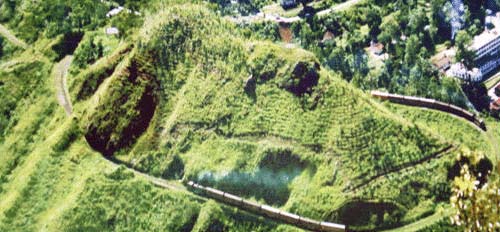 This is situated 01km. on the Spring Valley road from Demodara junction on the Bandarawela - Badulla road. The British rulers designed the up country Railway line and has been constructed going round a small hill and through a tunnel below. The station is on the top of the hill just above the tunnel. The distance around the hill is 990 yards (99.49m). According to legend, the shape of this railway lines has been derived from the "cowl worm" by the villagers.
This is situated 01km. on the Spring Valley road from Demodara junction on the Bandarawela - Badulla road. The British rulers designed the up country Railway line and has been constructed going round a small hill and through a tunnel below. The station is on the top of the hill just above the tunnel. The distance around the hill is 990 yards (99.49m). According to legend, the shape of this railway lines has been derived from the "cowl worm" by the villagers.
Soraborawawa Reservoir
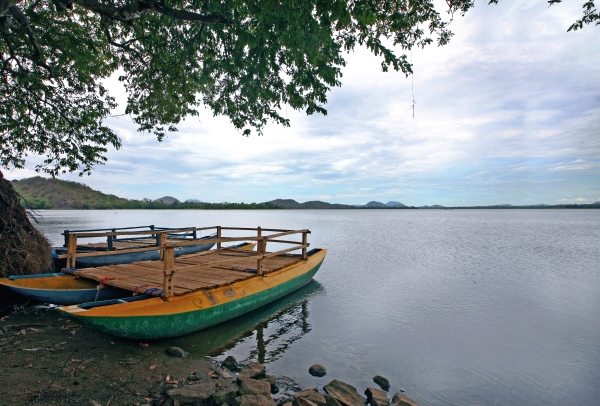 This is located about 2 km from Mahiyanganaya town which is one of the most tourist attractions in the area. This reservoir was build by a giant called "Bulatha". This was one of the marvelous creations of him. (The 10th century sorabora inscription) He was also the leader of the army of Dutugemunu and he had assisted immensely in repairing Mahiyangana temple. At present the water of this reservoir is taken for agricultural purposes. It offers superb opportunities to bath, good bird watching especially of woodland and aquatic variants and boat rowing.
This is located about 2 km from Mahiyanganaya town which is one of the most tourist attractions in the area. This reservoir was build by a giant called "Bulatha". This was one of the marvelous creations of him. (The 10th century sorabora inscription) He was also the leader of the army of Dutugemunu and he had assisted immensely in repairing Mahiyangana temple. At present the water of this reservoir is taken for agricultural purposes. It offers superb opportunities to bath, good bird watching especially of woodland and aquatic variants and boat rowing.
Vaddah's of Dambana (Indigenous People of Sri Lanka)
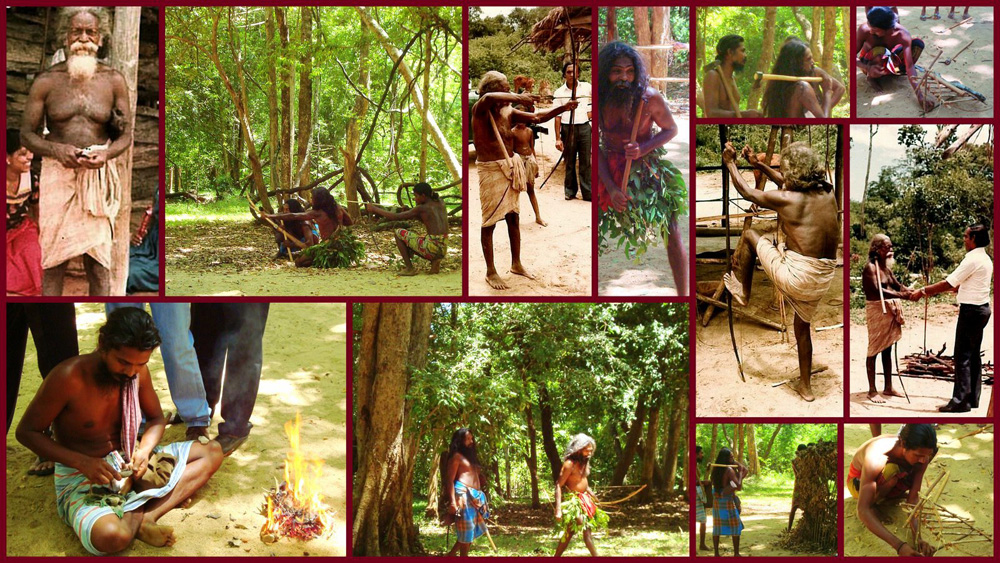 Veddhas, Sri Lanka's aboriginal inhabits are unspoiled and truly a fascinate people. They are believed to be descended from the Sri Lanka's Stone Age inhabitants. One of the oldest tribes in the world who have been preserving their culture and tradition without moving to modern world. The veddha people are related to the Austro - Asian people and speak an Indu Aryan language, which is much different from Sinhala language. These people are characterized by a dark brown complexion, long head with hair. Total population of pure veddaha is limited to a small member (about 2000) and this significant community settlement are scattered in Uve, Sabaragamuva, Notth- central and Eastern provinces. However, only Dambana in Mahiyangana has preserved the pure culture there inhabitants which is about six miles from Mahiyangana.
Veddhas, Sri Lanka's aboriginal inhabits are unspoiled and truly a fascinate people. They are believed to be descended from the Sri Lanka's Stone Age inhabitants. One of the oldest tribes in the world who have been preserving their culture and tradition without moving to modern world. The veddha people are related to the Austro - Asian people and speak an Indu Aryan language, which is much different from Sinhala language. These people are characterized by a dark brown complexion, long head with hair. Total population of pure veddaha is limited to a small member (about 2000) and this significant community settlement are scattered in Uve, Sabaragamuva, Notth- central and Eastern provinces. However, only Dambana in Mahiyangana has preserved the pure culture there inhabitants which is about six miles from Mahiyangana.
Namunukula Mountain Range
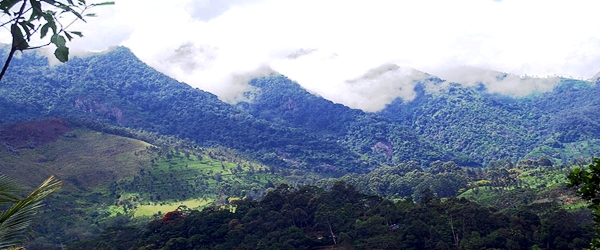 To reach this area, one has to travel 07 km along Spring Valley road from Badulla up to Kottegoda tea factory, turning to left. It is 11 km from there and it is necessary to go on foot about 06 km. The Namunukula peak, which is 6617 ft (2016.87m), is the highest mountain in Uva Province. This mountain range consists of clearly visible 09 tiny mountain peaks. On the top of the Namunukula mountain peak, there is a large plain. Rhododendron is one of the significant plants among the flora. There is a panoramic view from the top of the mountain and its view runs to the eastern coast and southern coast.
To reach this area, one has to travel 07 km along Spring Valley road from Badulla up to Kottegoda tea factory, turning to left. It is 11 km from there and it is necessary to go on foot about 06 km. The Namunukula peak, which is 6617 ft (2016.87m), is the highest mountain in Uva Province. This mountain range consists of clearly visible 09 tiny mountain peaks. On the top of the Namunukula mountain peak, there is a large plain. Rhododendron is one of the significant plants among the flora. There is a panoramic view from the top of the mountain and its view runs to the eastern coast and southern coast.




